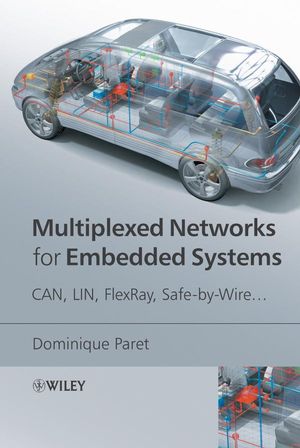Multiplexed Networks for Embedded Systems: CAN, LIN, FlexRay, Safe-by-Wire...ISBN: 978-0-470-03416-3
Hardcover
480 pages
July 2007
 |
||||||
Acknowledgements.
Part A CAN: from concept to reality.
1 The CAN bus: general.
1.1 Concepts of bus access and arbitration.
1.2 Error processing and management.
1.3 Increase your word power.
1.4 From concept to reality.
1.5 Historical context of CAN.
1.6 Patents, licences and certification.
2 CAN: its protocol, its properties, its novel features.
2.1 Definitions of the CAN protocol: ‘ISO 11898-1’.
2.2 Errors: their intrinsic properties, detection and processing.
2.3 The rest of the frame.
2.4 CAN 2.0B.
3 The CAN physical layer.
3.1 Introduction.
3.2 The ‘CAN bit’.
3.3 Nominal bit time.
3.4 CAN and signal propagation.
3.5 Bit synchronization.
3.6 Network speed.
4 Medium, implementation and physical layers in CAN.
4.1 The range of media and the types of coupling to the network.
4.2 High speed CAN, from 125 kbits -1 to 1 Mbits -1: ISO 11898-2.
4.3 Low speed CAN, from 10 to 125 kbits -1.
4.4 Optical media.
4.5 Electromagnetic media.
4.6 Pollution and EMC conformity.
5 Components, applications and tools for CAN.
5.1 CAN components.
5.2 Applications.
5.3 Application layers and development tools for CAN.
6 Time-triggered protocols – FlexRay.
6.1 Some general remarks.
6.2 Event-triggered and time-triggered aspects.
6.3 TTCAN – Time-triggered communication on CAN.
6.4 Towards high-speed, X-by-Wire and redundant systems.
6.5 FlexRay.
Part B New multiplexed bus concepts: LIN, FlexRay, Fail-safe SBC, Safe-by-Wire.
7 LIN – Local Interconnect Network.
7.1 Introduction.
7.2 Basic concept of the LIN 2.0 protocol.
7.3 Cost and market.
7.4 Conformity of LIN.
7.5 Examples of components for LIN 2.0.
8 Think ‘Bus’, think ‘Fail-safe SBC’, ‘Gateways’.
8.1 Fail-safe SBCs: their multiple aspects and reasons for using them.
8.2 The strategy and principles of re-use.
8.3 Demo board.
8.4 Gateways.
8.5 Managing the application layers.
9 Safe-by-Wire.
9.1 A little history.
9.2 Safe-by-Wire Plus.
9.3 Some words of technology.
10 Audio-video buses.
10.1 I2C Bus.
10.2 The D2B (Domestic digital) bus.
10.3 The MOST (Media oriented systems transport) bus.
10.4 The IEEE 1394 bus or ‘FireWire’.
11 RF communication and wireless mini-networks.
11.1 Radio-frequency communication: internal.
11.2 Radio-frequency communication: external.
11.3 Wireless networks.
Conclusion.
Part C Appendices.
Appendix A. CiA (CAN in Automation).
Appendix B. Essential references.
Appendix C. Further reading.
Appendix D. Useful addresses.
Index.



